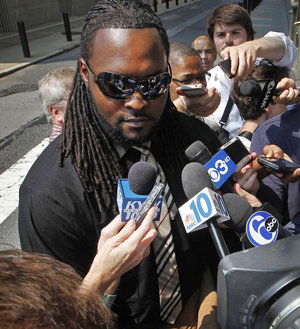Jurors in Priest Case Talk about Their Difficult Deliberations
By Joseph A. Slobodzian and Julie Zauzmer
In the end, jurors said, it was not about the Catholic Church or the prosecution's carefully crafted litany of Philadelphia priests who over the years abused children and got away with it. It was about two people and what they did, and what prosecutors proved beyond a reasonable doubt, said Isa Logan, foreman of the 12 Philadelphia Common Pleas Court jurors in the landmark Catholic Church sex-abuse trial. Logan, 35, a muscular, 6-foot-6 Army veteran, bank worker, and deacon of a nondenominational West Philadelphia church, met with reporters Friday afternoon and, above the noise of traffic around City Hall, tried to give some insight into the jurors' deliberations. "We followed the court's instructions and the evidence," said Logan, a father of three who said he gained a new appreciation for the vulnerability of children. He and two other jurors described the 121/2 days of deliberation as difficult, sometimes to the point of anger and frustration - "any emotion you could imagine," as one put it. But in the end, the seven men and five women made history. For the first time, an official of the Catholic Church was held criminally responsible for acts a jury found resulted in a sexual assault on a child. The jury found Msgr. William J. Lynn, 61, guilty of a felony count of child endangerment for allowing a known pedophile priest, Edward Avery, to reside at the rectory of St. Jerome parish in Northeast Philadelphia while he worked as a chaplain at nearby Nazareth Hospital. Lynn was the archdiocesan secretary for clergy from 1992 to 2004, a job that made him responsible for investigation into allegations of sex abuse of minors by priests. Though Avery - who pleaded guilty to sex-abuse charges before trial - was supposed to be supervised, in 1998 or 1999 he sexually assaulted a 10-year-old altar boy. The jury acquitted Lynn of two other counts - one of endangerment, involving the 14-year-old alleged victim of the Rev. James J. Brennan, Lynn's codefendant, and one count of conspiracy to endanger children. The jurors deadlocked on charges of attempted rape and child endangerment against Brennan, 48, resulting in a mistrial. But none of the jurors who agreed to be interviewed would discuss what divided the panel on Brennan's fate. All three said deliberations had been especially difficult before Wednesday, when the jury notified Judge M. Teresa Sarmina that it was deadlocked on four of five counts. "We were angry," said Taleah, 29, of Frankford, a clerk at the federal appeals court in Philadelphia who declined to give her last name. "There was frustration." "The people who were not on board, we tried to ask them, 'What is it to get past that point?' " Taleah said. "The vote changed throughout the deliberations," said Regan, 29, a medical researcher from South Philadelphia who also declined to give her last name. "When we first started, we were all split on most things, and then as we worked through it . . . we were split but kind of came closer." Neither could pinpoint what might have made a difference in the case against Brennan. Regan said the testimony of Brennan's accuser, now 30 years old, along with that of his mother, was insufficient. "We would have liked to hear him [Brennan] take the stand," she said. "The witnesses that we did have, we either didn't find them very credible or didn't think there was enough." As for the count on which they convicted Lynn, Taleah said that for her, "It was pretty open and shut." Logan said the hardest part for the jury was the conspiracy count against Lynn, because the lay definition was different from the legal one, which required jurors to determine if several elements or factors had been proven. Taleah, for example, said she had believed Lynn guilty of conspiring to endanger children because his decisions put them at risk. But she said she set aside that belief after the judge reiterated the elements of conspiracy. "We had to find that he conspired to endanger children, and we just don't think that happened," Taleah said. The jurors said they did not get mired in more than 1,900 documents prosecutors had introduced over 11 weeks of trial to show a pattern of how the archdiocese dealt with deviate priests over decades. Nor did they pay attention to news coverage that had been almost nonstop since charges against Lynn and Brennan were announced in February 2011. None said they knew of the March 22 guilty plea by Avery on the Thursday before the trial. ("I learned about it today," Regan said.) Nor did Avery's sudden absence from the defense table make an impression. "We weren't watching the news or reading the papers," Regan said. "We took it very seriously, whether there was media or not." Although Taleah said, "I would be upset if I was Catholic," Logan and Regan said the verdict was not a judgment on the religion. Regan, a Catholic who wears a small golden cross around her neck, said the case "was not about the Catholic Church. This was about the people who were on trial here." "Everybody in the Catholic Church is not bad, and I'm not changing my opinion about the church," she said. "There are just some people who do bad things, make bad decisions, and make bad choices." Contact Joseph A. Slobodzian at 215-854-2985, jslobodzian@phillynews.com or @joeslobo on Twitter.
|
.
Any original material on these pages is copyright © BishopAccountability.org 2004. Reproduce freely with attribution.
